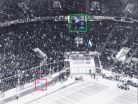(Press-News.org) A protein called PU.1 is essential for the development of dendritic cells, the sentinels of the immune system, Walter and Eliza Hall Institute researchers in Melbourne, Australia, have shown.
Dendritic cells (DC) are immune cells that present proteins from foreign invaders, such as viruses, to the killer T cells of the immune system, allowing a full immune response to be mounted against the invaders.
Researchers from the Immunology division have been studying dendritic cells and how different molecules regulate their development.
Dr Li Wu said one of the molecules that is known to be important to this development is a protein called Flt3 which is a cytokine receptor found on the surface of blood stem cells and the parent cells that give rise to DC.
"Despite its importance in early blood cell development and dendritic cell development, there is surprisingly little known about how Flt3 expression is controlled," Dr Wu said.
The team of Dr Sebastian Carotta, Dr Aleksandar Dakic, Ms Angela D'Amico, Mr Milon Pang and Dr Kylie Greig, led by Dr Stephen Nutt and Dr Li Wu, has shown the transcription factor PU.1 can directly bind to the Flt3 gene to regulate its expression. "PU.1 can therefore control DC development through regulating Flt3," Dr Wu said.
Dr Carotta said PU.1 was already known to be important to the development of blood cells and immune cells. "If PU.1 is poorly regulated there is a deficiency in the development of blood cells and leukaemia can result," he said.
"To study the role of PU.1 and look at how it's regulated we developed an animal model and a new in vitro system for tracing DC development from their precursors. These systems make it possible to switch off PU.1 in the precursor cells to DC. From that we determined that loss of PU.1 completely abolished DC development," Dr Carotta said.
Dr Wu said this study revealed PU.1 to be a master regulator of DC development. "Although a growing number of transcription factors have been implicated in the development of specific dendritic cell populations, this is the first time a single transcription factor has been shown to be required for all DC lineages," she said.
The study has been published in the journal Immunity.
Dr Wu said the findings had potential to improve DC-based therapies, such as those given to cancer patients who have suppressed DC function. "The problem is people don't know how to develop good DC for these therapies," she said. "By understanding how DC development is regulated it should be possible to create different types of DC populations for therapeutic use."
INFORMATION:
The study was supported by the National Health and Medical Research Council of Australia, the Australian Research Council, the Leukaemia Foundation and Pfizer Australia.
Protein behind development of immune system sentinels identified
2010-09-20
ELSE PRESS RELEASES FROM THIS DATE:
Citizen scientist
2010-09-20
We are all scientists now, thanks to SETI@home, Galaxy Zoo, The Great Sunflower Project, Folding@home and counltess other projects that allow individuals to take part in scientific research directly or indirectly. In the case of SETI@home and Folding@home one shares one's computer CPU with the researchers, whereas Galaxy Zoo is more about active involvement with the classification of stellar objects in images of the night sky, for instance.
Now, writing in the International Journal of Organisational Design and Engineering, US researchers have mapped out an approach to ...
Marine scientists unveil the mystery of life on undersea mountains
2010-09-20
They challenge the mountain ranges of the Alps, the Andes and the Himalayas in size yet surprisingly little is known about seamounts, the vast mountains hidden under the world's oceans. Now in a special issue of Marine Ecology scientists uncover the mystery of life on these submerged mountain ranges and reveal why these under studied ecosystems are under threat.
The bathymetry of our oceans is now resolved at a scale and detail unimaginable by early pioneers and recent estimates suggest that, globally, there may be up to 100,000 seamounts, yet despite best efforts less ...
Study gets measure of how best to prevent blood clots
2010-09-20
Treating hospital patients with thigh-length surgical stockings, rather than knee-high socks, can reduce life threatening blood clots, a new study suggests.
Researchers found that knee-high stockings, which are similar to flight socks, do little in stroke patients to prevent deep vein thrombosis (DVT), a life threatening form of blood clot that can travel up into the heart and lungs, .
The CLOTS (Clots in Legs Or sTockings after Stroke) study from the University of Edinburgh highlights that the clot rate in stroke patients was higher among those fitted with the shorter ...
The Amazon rainforest -- a cloud factory
2010-09-20
The forest in the Amazon Basin produces its own rain. During the wet season, aerosol particles, which serve to condensate clouds and precipitation here, mainly consist of organic material. These aerosols are released by the rainforest itself. This has been demonstrated by scientists from the Max Planck Institute for Chemistry in Mainz, who are now able to draw conclusions about the mechanisms of this ecosystem: the high content of organic material indicates that the Amazon Basin acts as a largely self-contained biogeochemical reactor during the rainy season. The results ...
Vigilant camera eye
2010-09-20
»Goal, goal, goal!« fans in the stadium are absolutely ecstatic, the uproar is enormous. So it's hardly surprising that the security personnel fail to spot a brawl going on between a few spectators. Separating jubilant fans from scuffling hooligans is virtually impossible in such a situation. Special surveillance cameras that immediately spot anything untoward and identify anything out of the ordinary could provide a solution. Researchers from the Fraunhofer Institute for Applied Information Technology FIT in Sankt Augustin have now developed such a device as part of the ...
Image sensors for extreme temperatures
2010-09-20
More and more car manufacturers are equipping their vehicles with image sensors – e.g. to register the presence of pedestrians or vehicles in the blind spot or to detect obstacles when parking. The sensors must be able to function in extremely high temperatures and in blazing sunlight. If they are installed behind the rear view mirror or on the instrument panel, for example, they can get very hot. The Fraunhofer Institute for Microelectronic Circuits and Systems IMS in Duisburg has developed a CMOS (complementary metal oxide semiconductor) image sensor for an industrial ...
Taking the pulse of coral reefs
2010-09-20
Healthy reefs with more corals and fish generate predictably greater levels of noise, according to researchers working in Panama. This has important implications for understanding the behaviour of young fish, and provides an exciting new approach for monitoring environmental health by listening to reefs.
Contrary to Jacques Cousteau's 'Silent World', coral reefs are surprisingly noisy places, with fish and invertebrates producing clicks and grunts which combine to produce cacophonies of noise. Each reef is subtly different depending on the size and composition of the ...
Earth's highest coastal mountain on the move
2010-09-20
The rocks of Colombia's Sierra Nevada de Santa Marta—the highest coastal mountain on Earth—tell a fascinating tale: The mountain collides and then separates from former super-continents. Volcanoes are born and die. The mountain travels from Peru to northern Colombia and finally rotates in a clockwise direction to open up an entirely new geological basin. Smithsonian scientists were part of a four-year project to study Santa Marta's geological evolution. Their findings are published in the October 2010 special issue of the Journal of South American Earth Sciences.
The study ...
Returning troops face both physical and mental challenges
2010-09-20
Is the US health system comprehensively meeting the needs of returning veterans? With the recent attention to mental illness in returning soldiers, and post-traumatic stress disorder (PTSD) in particular, little research has focused on the medical care needs of those returning from Operation Enduring Freedom/Operation Iraqi Freedom, according to Dr. Susan Frayne, from the VA Palo Alto Health Care System and Stanford University, and colleagues.
Their research highlights that veterans suffering from PTSD also suffer more medical illnesses than do those with no mental health ...
Cholesterol drug may have role in treating prostate cancer
2010-09-20
TORONTO, Ont., Sept. 20, 2010 – A drug commonly prescribed for people with high cholesterol may also be effective in treating prostate cancer, according to new research by Dr. Xiao-Yan Wen at St. Michael's Hospital.
Rosuvastatin—a statin drug sold as Crestor—suppressed the growth of transplanted human prostate cancer cells in mice.
"Our data provided solid pre-clinical evidence and a strong rationale for clinical trials of statins in the treatment of prostate cancer," said Wen, whose research appears in the September issue of European Urology, the journal of the European ...






